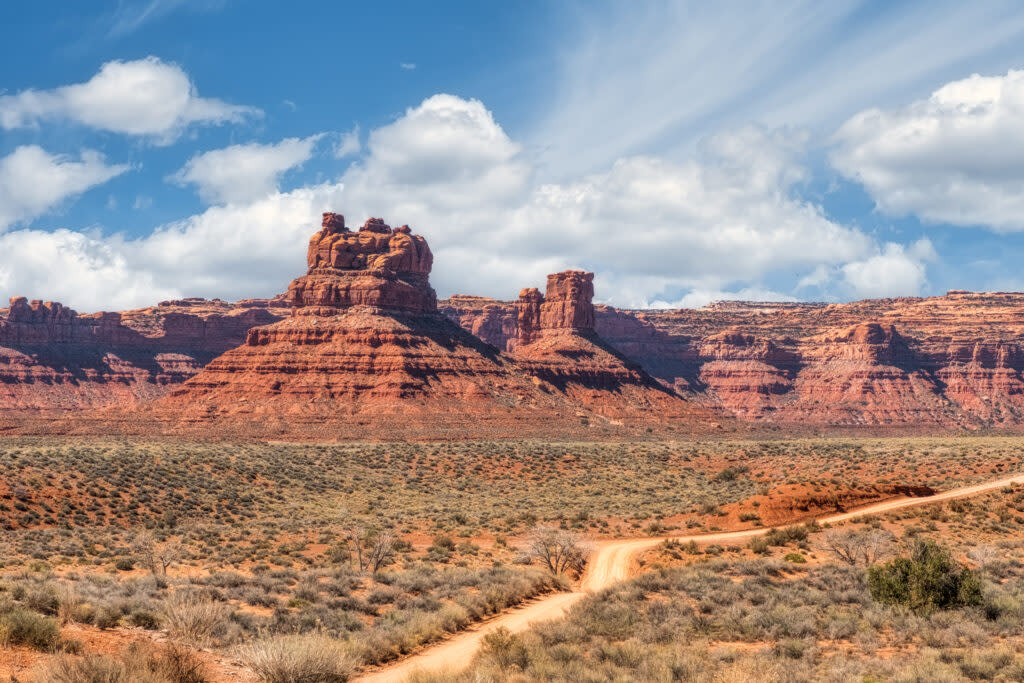The clock is ticking on sacred lands protection

Sandstone structures in Valley of the Gods, part of the Bears Ears National Monument near Mexican Hat, Utah. (Don Miller/Getty Images)
There’s a sense of urgency in presidential election years. Organizations, governments, and voters all have their eyes on the clock as the days of an administration that meets their needs potentially wind down. This is especially true for tribes and Native organizations looking to protect and steward their ancestral homelands.
Tribal co-management of public lands has become a political football in recent years. In the Obama administration, the Bears Ears National Monument was established; in the Trump administration, it was significantly reduced, and in the Biden administration, it was reinstated and expanded. The significance of this protection to Indigenous peoples can’t be overstated. More permanent protection of sacred places, the places we come from, where we gather medicines and foods, and hold ceremonies, isn’t just nice to have but essential to our survival.
Today, after years of advocacy from tribes and Native organizations, and input from the five tribes of the Bears Ears Commission, a draft plan to co-manage the natural resources and landscape of Bears Ears has been released for public comment. This plan, with the wisdom of traditional Indigenous knowledge behind it, aims to safeguard Bears Ears for generations to come. Now, with the comment period ending in just weeks, and an election looming, it’s a race against the clock to finalize and implement a plan to manage Bears Ears.
Every National Monument and National Park, every acre of public land, is Native land.
– Judith LeBlanc
Of course, there’s a better way to manage public lands, one that doesn’t follow the ups and downs of whoever is in the White House. Tribal nations must be co-managers of federal lands, with the same decision-making rights as federal agencies, as a matter of set federal policy.
Every National Monument and National Park, every acre of public land, is Native land. Many national parks and national monuments were created by violently removing Native people from our homelands, where our ancestors lived for thousands of years. This land theft is part of the U.S. history of systemic racism, but it has been erased from the national narrative. Instead, parks and monuments are portrayed as pristine and untouched. We’ve got to change this narrative and recognize that all public lands are on Indigenous homelands. And it is the tribes’ right to make decisions about their homelands.
For too long, federal land management laws have led to the desecration of sacred cultural sites on public lands. This is due to the exclusion of tribal input and co-management of these lands.
The five tribes of the Bears Ears Commission — Hopi, Zuni, Ute, Ute Mountain Ute, and Navajo — have an inherent right to determine the future of the Bears Ears National Monument. Their knowledge of this area dates back millennia. Native peoples view land, water, and animals of Earth as interconnected parts of a larger whole and in relationship with all that is around us. We understand our role in the time continuum, past, future, and present. In co-managing public lands, tribes bring forward the ways that our ancestors have always protected Mother Earth. Inclusion of traditional Indigenous knowledge in co-management is not only the inherent right of tribes, but a best practice that ensures these public lands are available for the use and enjoyment of future generations, Native and non-Native.
The politics of land management and conservation are inevitable, but there are long-term solutions. While the Biden administration has issued an order that directs federal agencies to “consider co-management, collaborative management, and co-stewardship of lands and waters,” it doesn’t go far enough. This guidance doesn’t require agencies to act. Instead, it asks them to “consider” co-stewardship of federal lands and waters with tribes. But let’s be clear: co-stewardship and co-management are already Indigenous peoples’ inherent, legal rights. A federal policy requiring tribal co-management and equal decision-making, and inclusion of traditional Indigenous knowledge in public lands management, is needed to ensure that the lands we all rely upon and enjoy remain for many years to come.
The co-management of the Bears Ears National Monument is a testament to what is possible when the federal government recognizes the inherent rights of tribes to determine the present and future of public lands. The current draft management plan incorporates the five tribes’ Indigenous knowledge, and their deep history and understanding of Bears Ears makes for a stronger resource management plan that balances access and protection.
Co-governing with Indigenous people isn’t just good policy that gets votes in the short-term, it’s a long-term solution that ensures the public lands we enjoy for culture, ceremony, recreation, and resources, continue to thrive well after we are gone.
ICT originally published this article. ICT is an an independent, nonprofit, multimedia news enterprise that covers Indigenous peoples.
SUBSCRIBE: GET THE MORNING HEADLINES DELIVERED TO YOUR INBOX
The post The clock is ticking on sacred lands protection appeared first on Alaska Beacon.

